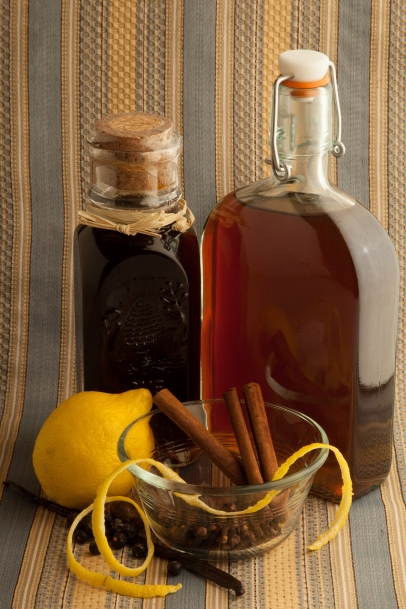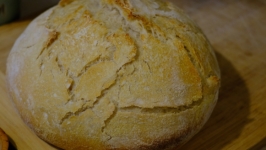Celebrating Heritage by the Glass
Food traditions take center stage during the holiday season. Parties with family, friends and colleagues are the time to celebrate and share all that connects us to each other and the past.
And if your past includes Polish lineage, you may be familiar with krupnik, a honey liqueur.
“This is not only a recipe that we all enjoy. It’s bonding, it’s connection, it’s heritage; it’s everything that is important,” says Rev. Czeslaw Michal Krysa, a Roman Catholic priest and the rector of the Church of Saint Casimir in Buffalo. The son of Polish immigrants, he grew up helping his father make many specialties from the old country, including krupnik.
“Everybody came to our house to have the homemade stuff. My father’s side of that was the krupnik and the smoked sausage,” he explains. “These were mostly immigrant families and every house had its own reason why people liked to come to the house. Krupnik, from our house, was known all over the place.”
Father Krysa describes krupnik as “a winter drink,” usually served at the start of the Christmas holiday through Lent. Each year, he starts making it around Thanksgiving.
“It’s one of the things you do, like putting up a Christmas tree, like putting up the lights outside on the house,” Krysa adds. “The smell in the house from all the spices, alcohol, and honey cooking—you can’t compare it to anything! It creates a warm, welcoming, comfortable atmosphere in the home.”
His family recipe starts with unpasteurized buckwheat honey from a farmers’ market mixed with spring water. Spices, including vanilla, nutmeg, cloves and cinnamon (and sometimes lemon peel), are wrapped in a clean dishtowel and broken up with a hammer. When the honey/water mixture is heated the spices are added and allowed to steep. After straining the spices, the honey is mixed with the alcohol. In the early days, people used Polish grain alcohol called Spirytus that was readily available; now vodka is employed. (Note: Father Krysa saves a bottle from each batch and jokes that those will be served at his funeral lunch.)
Krysa makes the liqueur at home to keep the tradition alive, but also because it tastes better than even the better commercial brands—so it’s beloved by those who know how good the homemade version tastes. At Saint Casimir’s parish, fundraising dinners featuring the beverage are very popular.
As important as the tradition of making krupnik is, so, too, is the way one shares the drink. Krysa recalls his family celebrations always starting with a formal toast. His father ceremoniously poured the drink into crystal krupnik glasses imported from Poland and served each guest’s drink from a special crystal plate. Everyone was included, and he says it made the get-togethers very memorable.
Like Father Krysa, Mike Argentieri breaks out special drinks during the holidays and other gatherings of family or friends.
Argentieri is a local attorney and food enthusiast. He enjoys cooking, eating, drinking and making food products at home.
“If I have the equipment and the wherewithal, I will try to make something on my own,” Argentieri says.
He credits his paternal grandfather, Almerindo, who passed on generations of acquired knowledge of making food and beverages at home including prosciutto, sausage, wine and grappa— a spirit made from remnants of the winemaking process.
“Nobody ever drank it all that much,” he adds. “It’s like turpentine. It’s very alcoholic and it’s something that you do with the dregs of the wine and distill it out. It’s crystal clear and you could just about breathe fire afterwards. Almerindo would take fresh fruit and float it in there. Then they would drink it, with a little bit of flavor.”
A trip that Argentieri took to Italy in August 2001 included drinking homemade limoncello, a lemon-flavored liqueur. He mistakenly thought it was made with lemon peels in the same way that grappa was produced with grape skins. Not being a distiller and a little nervous about the process, he did not pursue crafting it when he returned home.
That changed when he came upon a limoncello recipe and realized that by steeping the fruit in the distilled spirit, his grandfather’s method of floating fruits in the grappa was just a few steps away from homemade limoncello.
For a reasonable price, you can buy a bottle at practically any liquor store, but Argentieri likes that making it at home lets him determine how lemony or sweet it turns out. He also controls its purity, which is something that you don’t get from a limoncello that is commercially produced.
Buoyed by the limoncello experience, Argentieri now produces liqueur from orange peels (arancello) and something he calls “Peach Pie,” which incorporates peaches, cinnamon and other spices typically found in the dessert. He also makes beer, wine and mead. He’s interested in experimenting with a liqueur from pistachios, so that will be Argentieri’s next project.
He says that if he knew how easy the process was, he would have started creating these sorts of libations sooner. However, Argentieri suggests drinking them with caution.
“It can knock you on your butt if you’re not careful; it’s like candy. It goes down smoothly but the next thing you know you’re singing ‘O Solo Mio!’”
Perhaps the start of another holiday tradition?









